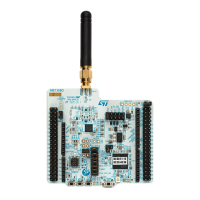Inter-integrated circuit (I2C) interface RM0453
1082/1450 RM0453 Rev 5
Introduction
The system management bus (SMBus) is a two-wire interface through which various
devices can communicate with each other and with the rest of the system. It is based on I
2
C
principles of operation. The SMBus provides a control bus for system and power
management related tasks.
This peripheral is compatible with the SMBus specification (http://smbus.org).
The system management bus specification refers to three types of devices
• A slave is a device that receives or responds to a command.
• A master is a device that issues commands, generates the clocks and terminates the
transfer.
• A host is a specialized master that provides the main interface to the system’s CPU. A
host must be a master-slave and must support the SMBus host notify protocol. Only
one host is allowed in a system.
This peripheral can be configured as master or slave device, and also as a host.
Bus protocols
There are eleven possible command protocols for any given device. A device may use any
or all of the eleven protocols to communicate. The protocols are Quick Command, Send
Byte, Receive Byte, Write Byte, Write Word, Read Byte, Read Word, Process Call, Block
Read, Block Write and Block Write-Block Read Process Call. These protocols must be
implemented by the user software.
For more details on these protocols, refer to SMBus specification (http://smbus.org).
Address resolution protocol (ARP)
SMBus slave address conflicts can be resolved by dynamically assigning a new unique
address to each slave device. In order to provide a mechanism to isolate each device for the
purpose of address assignment each device must implement a unique device identifier
(UDID). This 128-bit number is implemented by software.
This peripheral supports the Address Resolution Protocol (ARP). The SMBus Device
Default Address (0b1100 001) is enabled by setting SMBDEN bit in I2C_CR1 register. The
ARP commands must be implemented by the user software.
Arbitration is also performed in slave mode for ARP support.
For more details of the SMBus address resolution protocol, refer to SMBus specification
(http://smbus.org).
Received command and data acknowledge control
A SMBus receiver must be able to NACK each received command or data. In order to allow
the ACK control in slave mode, the Slave Byte Control mode must be enabled by setting
SBC bit in I2C_CR1 register. Refer to Slave byte control mode for more details.
Host notify protocol
This peripheral supports the host notify protocol by setting the SMBHEN bit in the I2C_CR1
register. In this case the host acknowledges the SMBus host address (0b0001 000).
When this protocol is used, the device acts as a master and the host as a slave.

